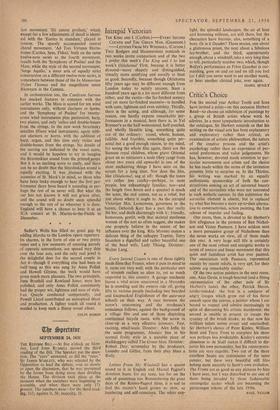Critic's Choice
FOR the second year Arthur Tooth and Sons have invited a critic—on this occasion Herbert Read—to choose an exhibition of paintings by a group of British artists whose work he admires. In a most sympathetic introduction to the catalogue, Sir Herbert reminds us that his writing on the visual arts has been explanatory and exploratory rather than critical, an examination of artistic philosophies, the nature of the creative process and the artist's psychology rather than an expression of per- sonal preferences and value judgements. He has, however, devoted much attention to par- ticular movements and artists and the choice he has made within the terms of the invitation presents little to surprise us. In the Thirties, his writing was marked by an equally enthusiastic sponsorship of both the con- structivists seeking an art of universal beauty and of the surrealists who were not interested in such esthetic canons. In this exhibition the surrealist clement is absent, but is replaced by what has become a more up-to-date alterna- tive to constructivism, action painting, the free release of impulse and feeling.
One room, 'then, is devoted to Sir Herbert's first allegiance in the persons of Ben Nichol- son and Victor Pasmore. I have seldom seen a more persuasive group of Nicholsons than the seven works on view, all of them made this year. A very large still life is certainly one of the most robust and energetic works in terms of texture and linear movement that this quiet and fastidious artist has ever painted. The association with Pasmore, represented mainly by recent reliefs, is very apt, for their talents are remarkably similar.
Of the two action painters in the next room, one. Alan Davie, is tough-hearted (and a fitting representative of the other pole of Sir Herbert's taste), the other, Patrick Heron, tender-minded: the first is a conjuror of angry images which grow out of his fierce assault upon the canvas, a painter whom I am bound to respect and admire increasingly in spite of distrusting his artistic standpoint; the second is unable at present to escape the tyranny of the brush stroke, so that now his brilliant talent seems errant and unattached. Sir Herbert's choice of Peter Kinley, William Scott and Terry Frost to complete his show was perhaps less predictable. Kinley's extreme closeness to de Stael makes it difficult to dis- cover his own personality, but his reinterpreta- tions are very capable, Two out of the three excellent Scotts are reminiscent of the same painter, but these very beautiful still lifes belong most securely to Scott's own evolution. The Frosts are as good as any pictures by him I have seen, but I was disturbed to see one of them being invaded by those fashionable rectangular taches which are becoming the picturesque tokens of the late 1950s.
BASIL TAYLOR


































 Previous page
Previous page